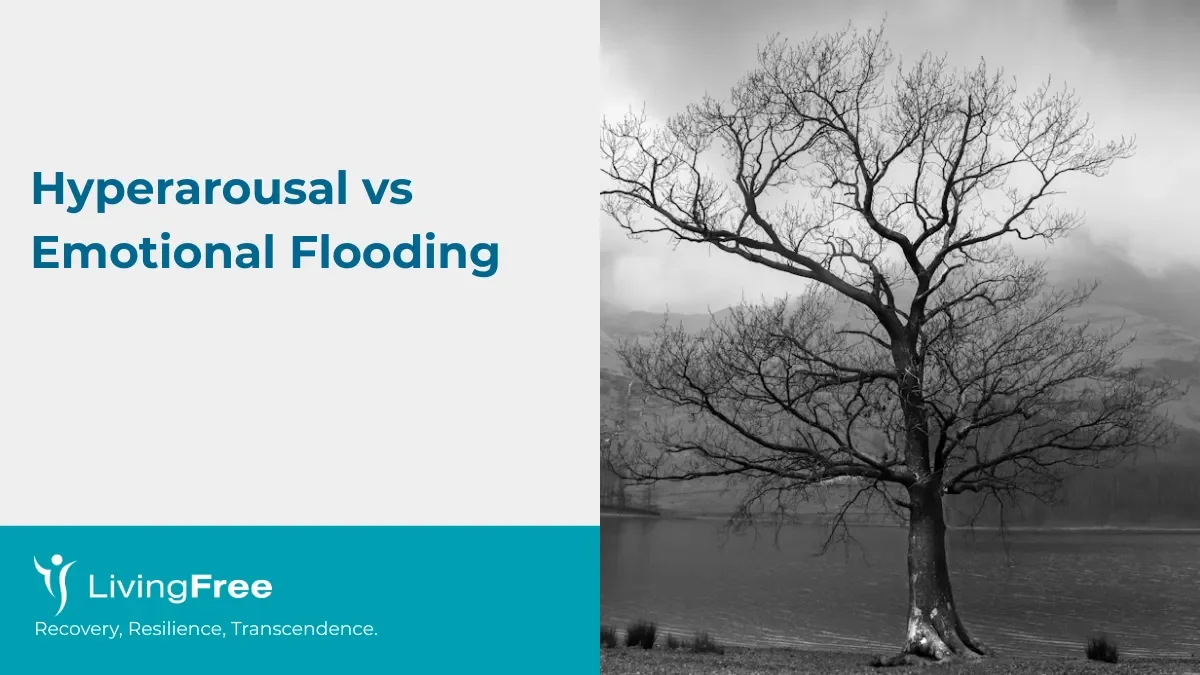Hyperarousal and emotional flooding are often used to describe similar experiences, but they are not exactly the same. Both involve intense activation of the nervous system, yet they show up in different ways and play different roles in trauma and relationship dynamics.
Understanding the difference can help you make sense of your reactions, respond with more compassion, and choose the right tools for regulation and healing.
What Is Hyperarousal?
Hyperarousal is a state where your nervous system stays on alert, even when there is no current danger. It is common in trauma, PTSD, chronic stress, and anxiety. In this state, your body prepares to protect you through fight, flight, freeze, or appease, even in everyday situations.
Signs of hyperarousal can include:
- Feeling constantly on edge or “keyed up”
- Difficulty relaxing or feeling safe
- Racing thoughts or mental restlessness
- Heightened startle response
- Sleep problems, such as trouble falling or staying asleep
- Ongoing irritability, tension, or anger
- Hypervigilance and scanning for threat
Hyperarousal is often a chronic baseline state. The nervous system has learned to stay vigilant to survive, even long after the original threat has passed.
What Is Emotional Flooding?
Emotional flooding is a more acute experience. It happens when emotions become so intense that you feel overwhelmed, disoriented, or unable to think clearly. It is common during conflict, especially in close relationships, and is frequently described in attachment and couples work.
Signs of emotional flooding can include:
- A sudden wave of intense emotion (fear, shame, anger, panic, helplessness)
- Feeling mentally “blank” or unable to find words
- Feeling like you are drowning in your feelings
- Strong urge to escape, shut down, or lash out
- Difficulty hearing or processing what the other person is saying
- Physical sensations such as tight chest, nausea, shaking, or dizziness
Emotional flooding is usually a moment-to-moment reaction. It is often triggered by a specific interaction, memory, or perceived threat in a relationship.
Key Differences Between Hyperarousal and Emotional Flooding
1. State vs Spike
Hyperarousal tends to be a more continuous state. The nervous system is turned up most of the time. It is like living with the volume dial on your internal alarm system set too high.
Emotional flooding is more like a sudden spike. It is an intense surge of emotional activation that can overwhelm your ability to think, speak, or stay present in the moment.
2. Baseline vs Triggered Response
Hyperarousal often functions as a baseline, especially for people with trauma histories. The body stays in readiness mode, always scanning for danger, even in neutral situations.
Emotional flooding is usually a triggered response. It is tied to specific cues such as a partner’s tone of voice, facial expression, a certain phrase, or a reminder of earlier experiences of shame, rejection, or abandonment.
3. Cognitive Experience
In hyperarousal, the mind may feel busy, restless, or hypervigilant. Thoughts race, risks are analysed, plans are made, and it can feel impossible to “switch off.”
In emotional flooding, the mind often feels blank, foggy, or overwhelmed. You may lose access to words, logic, or perspective. Some people describe it as “shutting down from the inside” or “going offline.”
4. Duration
Hyperarousal can last for hours, days, or longer. It becomes part of how the nervous system operates day to day.
Emotional flooding is usually shorter in duration but more intense. It may last from a few minutes to a few hours during or after a specific incident, especially during arguments or emotionally charged conversations.
5. Relational Context
Hyperarousal can appear across many areas of life. It may show up at work, while driving, in social settings, when alone, or when trying to sleep. It is not limited to relationships.
Emotional flooding is often more relational. It frequently appears in close relationships when there is conflict, misunderstanding, criticism, or a perceived loss of connection.
How Hyperarousal and Emotional Flooding Overlap
Although they are different, hyperarousal and emotional flooding are closely linked.
- Hyperarousal creates a sensitive background state that makes emotional flooding more likely.
- If your nervous system is already on high alert, a small trigger in a relationship can feel enormous and lead to flooding.
- Both involve activation of the stress response and can include fight, flight, freeze, or appease reactions.
- Both can lead to difficulties with communication, decision-making, and problem-solving in the moment.
Many people live with a chronic layer of hyperarousal and then experience emotional flooding during specific relational stressors.
Examples: What It Can Look Like in Real Life
Example of Hyperarousal
You wake up already feeling tense and alert. Throughout the day, you are jumpy at sudden sounds, find it hard to relax, and notice your thoughts repeatedly scanning for what might go wrong. By evening, your body is tired but your mind is still running.
Example of Emotional Flooding
You are having a conversation with your partner about something small, like house chores. Their tone shifts slightly or they sigh. Suddenly, your chest tightens, your heart pounds, and you feel either like shouting, crying, or leaving the room. You struggle to hear their words and feel “overwhelmed” by the emotional intensity.
In this example, emotional flooding is the intense wave during the conversation. Hyperarousal is the ongoing background tension that makes that wave easier to trigger.
How to Tell Which One You Are Experiencing
You may be experiencing hyperarousal if:
- The sense of being on edge lasts for long periods
- You feel restless or vigilant even when nothing specific is happening
- You have ongoing sleep problems and difficulty relaxing
- Your body often feels tense, even in safe environments
You may be experiencing emotional flooding if:
- There is a sudden shift from “okay” to overwhelmed
- You feel like your emotions are “too much” all at once
- You find it hard to think, speak, or follow what the other person is saying
- You feel a strong urge to escape, shut down, or attack in the moment
It is also possible to experience both. For many people, a chronically hyperaroused system gets pushed into emotional flooding when a trigger feels too close or too familiar.
Coping With Hyperarousal
When you are dealing with hyperarousal, the goal is to help your nervous system find a calmer baseline. This is often about daily regulation and lifestyle, rather than only reacting in crisis moments.
Helpful approaches include:
- Breathwork and grounding: Slow, even breathing, feeling your feet on the floor, or using the 5-4-3-2-1 senses exercise.
- Body-based practices: Gentle stretching, yoga, walking, or other regular movement.
- Sleep and routine: Creating predictable rhythms for sleep, meals, and rest.
- Reducing stimulants: Limiting caffeine, nicotine, and alcohol, especially later in the day.
- Therapeutic support: Trauma-informed therapies such as EMDR, Somatic Experiencing, or polyvagal-informed work.
Coping With Emotional Flooding
When emotional flooding happens, you often need acute, in-the-moment strategies to reduce intensity and regain enough clarity to choose your next step.
Helpful steps include:
- Pause the interaction if possible: Take a short break from the conversation or situation.
- Move your body: Stand up, walk, or change your posture to signal a shift to your nervous system.
- Cool down the system: Splash cool water on your face, hold something cold, or step into fresh air.
- Orient to the present: Look around the room and name where you are and what you are doing now.
- Use simple self-talk: Phrases like “I am overwhelmed, but I am safe in this moment” can help.
If you are in a relationship, it can help to say something like:
“I am feeling flooded right now. I cannot hear everything clearly. I need a short break so I can come back and talk about this more calmly.”
How Partners and Loved Ones Can Help
Many people experience emotional flooding and hyperarousal most intensely in close relationships. Partners, family members, or friends can play a supportive role without taking responsibility for “fixing” the other person.
Supportive responses include:
- Staying as calm and grounded as possible
- Using a soft, steady tone of voice
- Respecting requests for a break during conflict
- Avoiding criticism or shaming in heated moments
- Checking in later with curiosity rather than blame
A simple, supportive phrase might be:
“I can see this feels like a lot right now. We can slow down. We do not have to solve everything in this moment.”
When to Seek Professional Help
If hyperarousal or emotional flooding are frequent, intense, or affecting your relationships, work, or health, it may be helpful to seek support from a trauma-informed therapist or mental health professional.
Therapy can help you:
- Understand why your nervous system reacts the way it does
- Process unresolved trauma or chronic stress
- Learn regulation tools that fit your body and history
- Improve communication and conflict repair in relationships
Bringing Compassion to Both Experiences
Both hyperarousal and emotional flooding are signs of a nervous system that is trying to protect you. These patterns were shaped by experiences that felt too much, too fast, or not safe enough.
You are not “too sensitive” or “overreacting.” Your system is doing what it learned to do in order to survive.
With awareness, support, and practice, you can help your body learn that it no longer has to live in constant alarm, and that intense waves of emotion can be met with care rather than shame.


